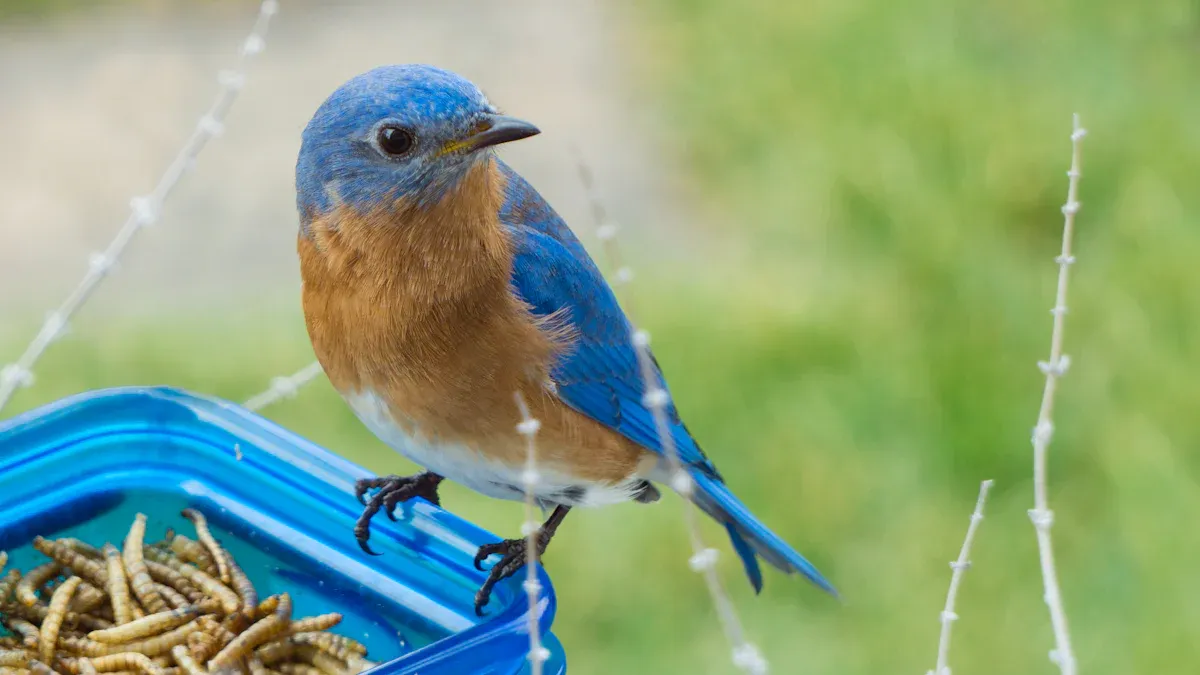
Have you ever wondered why dried mealworms for pet food are gaining so much attention? These tiny powerhouses pack up to 55% protein and essential amino acids, making them a top-notch choice for pet nutrition. Plus, their eco-friendly production, like converting organic waste into protein biomass, ensures you’re making a sustainable choice for your furry friends.
Key Takeaways
- Dried mealworms are full of protein, with about 55%. Protein is important for your pet’s health and energy.
- These mealworms are healthy and simple to digest. They are a great food option for pets like reptiles and birds.
- Picking dried mealworms helps the environment. They use less land and water than other protein sources, helping pets and the Earth.
Nutritional Benefits of Dried Mealworms for Pet
High Protein Content for Pet Health
When it comes to protein, dried mealworms for pet food are hard to beat. These tiny insects pack a punch with up to 51% protein on a dry matter basis. That’s a game-changer for your pet’s health! Protein is essential for muscle growth, tissue repair, and overall vitality.
- Dried yellow mealworm larvae (Tenebrio molitor) are rich in essential nutrients.
- Their nutritional profile rivals traditional protein sources like chicken or fish.
- High protein levels ensure your pet gets the energy they need to stay active and healthy.
Rich in Essential Vitamins and Minerals
Dried mealworms for pet food aren’t just about protein. They’re also loaded with vitamins and minerals that support your pet’s well-being. Studies show that mealworms can be enriched with calcium and phosphorus through specific diets, making them even more beneficial.
| Study Focus | Findings |
|---|---|
| Nutritional Quality of Mealworms | Mealworms can be enhanced with calcium and phosphorus through tailored diets. |
| Intestinal Loading Method | Feeding mealworms nutrient-dense diets boosts their vitamin content. |
| Calcium Intake | Adjusting mealworm diets improves their calcium levels for pets. |
A Natural and Digestible Food Source
Mealworms are not only nutritious but also easy for pets to digest. Research highlights their high digestibility and absorption rates, making them a natural choice for pet food.
- Mealworm protein is as digestible as milk protein, ensuring maximum nutrient absorption.
- With up to 71% protein content, they’re one of the most concentrated protein sources available.
- Their natural composition makes them a sustainable and appetizing option for pets.
Research from the University of Illinois confirms that mealworms are high-quality protein sources with over 90% amino acid digestibility. This makes them an excellent addition to your pet’s diet.
Quality Assurance in Dried Mealworms for Pet Food
Ethical and Reliable Sourcing Practices
When you choose dried mealworms for pet food, you want to know they come from ethical and reliable sources. That’s why trusted suppliers prioritize transparency in their farming practices. They ensure mealworms are raised in clean, controlled environments and fed high-quality, nutrient-rich diets. This guarantees not only the health of the mealworms but also the safety of the pets consuming them.
Many suppliers also follow strict environmental guidelines. For example, mealworm farming uses significantly less land and water compared to traditional livestock farming. By sourcing from these eco-conscious farms, you’re supporting a sustainable future while providing top-notch nutrition for pets.
Stringent Production Standards
The production process for dried mealworms is no less rigorous. Suppliers adhere to global food safety standards like ISO 22000 to ensure the highest quality. Advanced drying technologies, such as pulsed electric field (PEF) and convective drying, are used to preserve the nutritional value while extending shelf life.
- Energy-efficient systems, like those required in the Netherlands, consume ≤0.8 kWh per kilogram of product.
- Retailers now demand sustainability credentials, pushing suppliers to meet strict benchmarks.
These measures ensure that every batch of mealworms meets the expectations of both pet food brands and eco-conscious consumers.
Comprehensive Quality Control Measures
Quality control is the backbone of any reliable pet food ingredient. For dried mealworms, this involves testing for physicochemical properties, nutritional value, and techno-functional characteristics.
| Quality Assurance Metric | Description |
|---|---|
| Physicochemical properties | Ensures the quality of yellow mealworm powders used in pet food. |
| Nutritional value | Confirms protein and fat content for balanced pet food formulation. |
| Techno-functional properties | Evaluates usability in food applications, like cohesiveness and absorption. |
| Drying technology | Impacts shelf life and quality, ensuring consistency in every batch. |
| Consumer acceptance | Focuses on preferences for insect powders over whole insects in pet food. |
These checks ensure that dried mealworms for pet food are safe, nutritious, and easy to integrate into various products. You can trust that every step of the process is designed to deliver the best for your pets.
Versatility of Dried Mealworms for Pet Food
Suitable for a Variety of Pets
Dried mealworms are a hit with many pets. Whether you have a bearded dragon, leopard gecko, or even a veiled chameleon, these little protein-packed snacks are perfect. Birds love them too! The larvae of T. molitor are widely recognized for their nutritional value, making them a go-to choice for reptiles and birds alike.
If you’re looking for a versatile food option, dried mealworms fit the bill. They’re not just for exotic pets. Many small mammals, like hedgehogs and sugar gliders, enjoy them as well. Their natural taste and high digestibility make them a favorite across species.
Enhancing the Nutritional Profile of Pet Food Products
Adding dried mealworms to pet food is like giving it a supercharged boost. These tiny insects are packed with 50-60% protein by dry weight. They also deliver essential amino acids, vitamins, and minerals like iron, zinc, and B vitamins.
Want to make your pet food stand out? Dried mealworms can elevate its nutritional value while keeping it natural and wholesome.
Their nutrient density ensures your pets get the energy and nourishment they need to thrive. Plus, they’re a sustainable alternative to traditional protein sources, which means you’re making a choice that’s good for your pets and the planet.
Easy Integration into Different Pet Food Formats
Dried mealworms are incredibly easy to work with. You can blend them into powdered pet food, mix them into pellets, or even use them as a crunchy topping. Their versatility doesn’t stop there. They can be incorporated into wet food, dry kibble, or even as a standalone treat.
Here’s why they’re so adaptable:
- They’re lightweight and easy to store.
- Their long shelf life makes them convenient for pet owners.
- They retain their nutritional value even after processing.
Whether you’re formulating food for reptiles, birds, or small mammals, dried mealworms for pet food are a flexible and nutritious ingredient.
Environmental Sustainability of Dried Mealworms for Pet Food

Low Environmental Impact Compared to Traditional Protein Sources
Did you know that dried mealworms have a much smaller environmental footprint compared to traditional protein sources like beef or chicken? They produce significantly fewer greenhouse gas emissions and require less land and water. Check out this comparison:
| Indicator | Mealworms | Milk | Chicken | Pork | Beef |
|---|---|---|---|---|---|
| Greenhouse Gas Emissions (GWP) | Low | 1.77–2.80× as high | 1.32–2.67× as high | 1.51–3.87× as high | 5.52–12.51× as high |
| Energy Use | Higher | 21–83% of mealworm | 46–88% of mealworm | Similar to mealworm | 1.02–1.58× as high |
| Land Use | Much less | Similar | Similar | Much more | Much more |
Mealworms are a sustainable choice for pet food brands looking to reduce their environmental impact. They’re a win for the planet and your pets!
Efficient Resource Use in Mealworm Farming
Mealworm farming is incredibly resource-efficient. These tiny insects convert feed into protein more effectively than traditional livestock. For example:
- Mealworms need less than 2 kg of feed to gain 1 kg of body weight. Compare that to chickens (2.5 kg), pigs (5 kg), or cattle (10 kg).
- Up to 80% of a mealworm is edible, while only 55% of a pig or chicken is usable.
Mealworms can even thrive on organic waste like vegetable scraps, reducing environmental contamination. Plus, they require far less land and water than livestock farming. By choosing dried mealworms for pet food, you’re supporting a sustainable and efficient farming system.
Alignment with Eco-Conscious Brand Values
If your brand values sustainability, mealworms are the perfect fit. They align with eco-conscious goals by using fewer resources and emitting fewer greenhouse gases. Here’s why they’re a great choice:
- They use 40% less land and 30% less water than traditional livestock.
- Their greenhouse gas emissions are only 40% of what’s produced by conventional animal farming.
- They offer a complete nutritional profile, making them both eco-friendly and nutritious.

By incorporating dried mealworms into your pet food products, you’re not just feeding pets—you’re helping the planet.
Premium dried mealworms for pet food are a game-changer. They offer unmatched nutrition, strict quality standards, and incredible versatility. Plus, they’re eco-friendly, making them a smart choice for your brand. By choosing them, you can create products that pets love and align with sustainability goals. Why not make the switch today?
FAQ
What pets can eat dried mealworms?
Dried mealworms are great for reptiles, birds, and small mammals like hedgehogs. They’re versatile and loved by many pets due to their taste and nutrition.
How should you store dried mealworms?
Keep them in a cool, dry place. Use an airtight container to maintain freshness and prevent moisture. Proper storage ensures they stay nutritious and safe for your pets.
Are dried mealworms safe for all pets?
Yes, they’re safe for most pets. However, always check with your vet if your pet has specific dietary needs or allergies to ensure they’re suitable.


